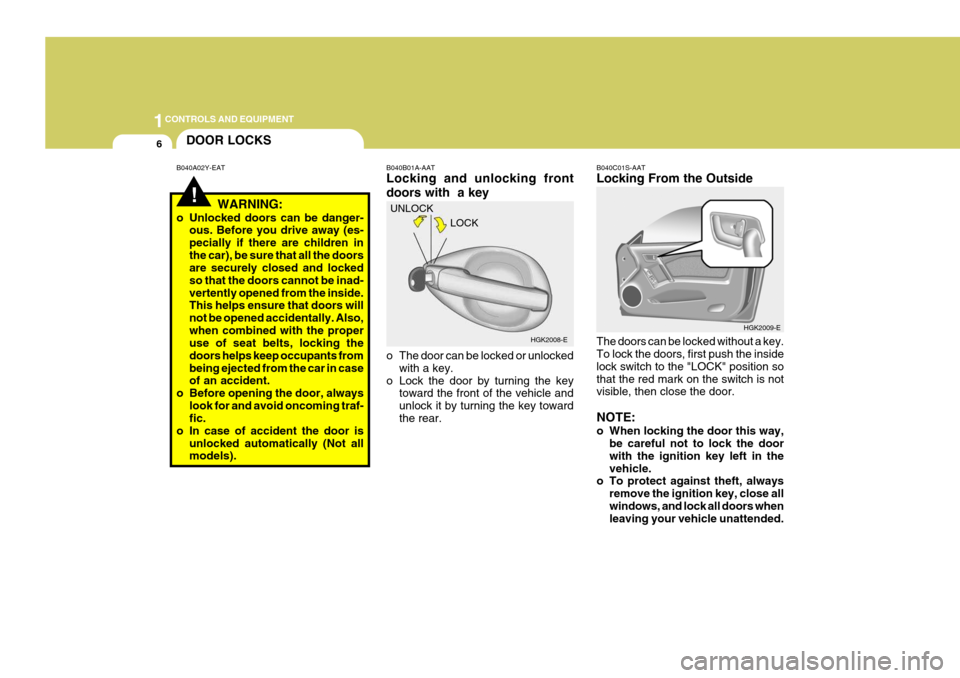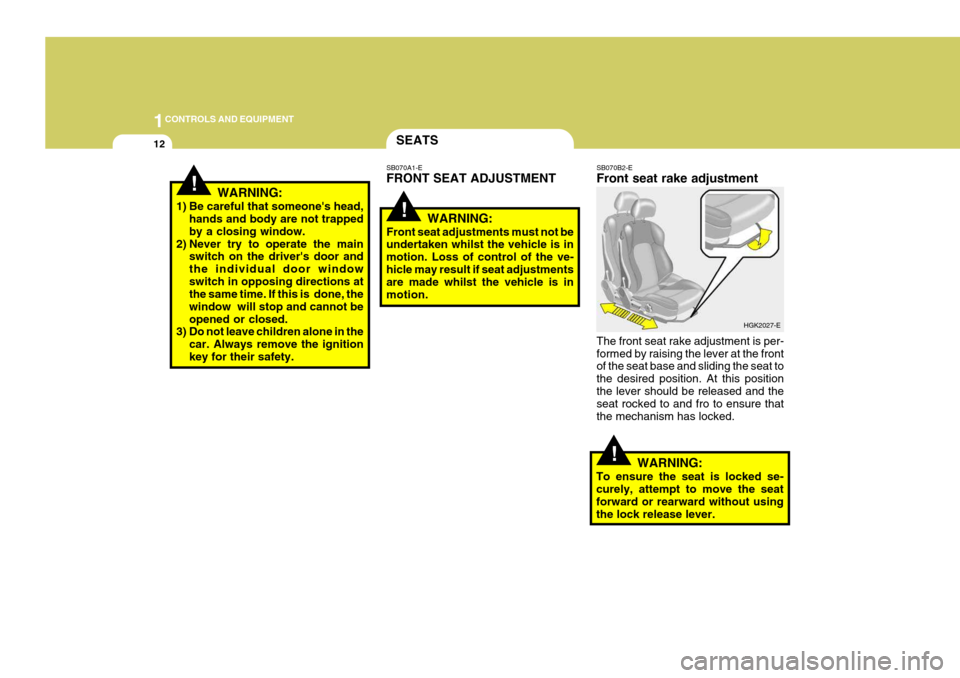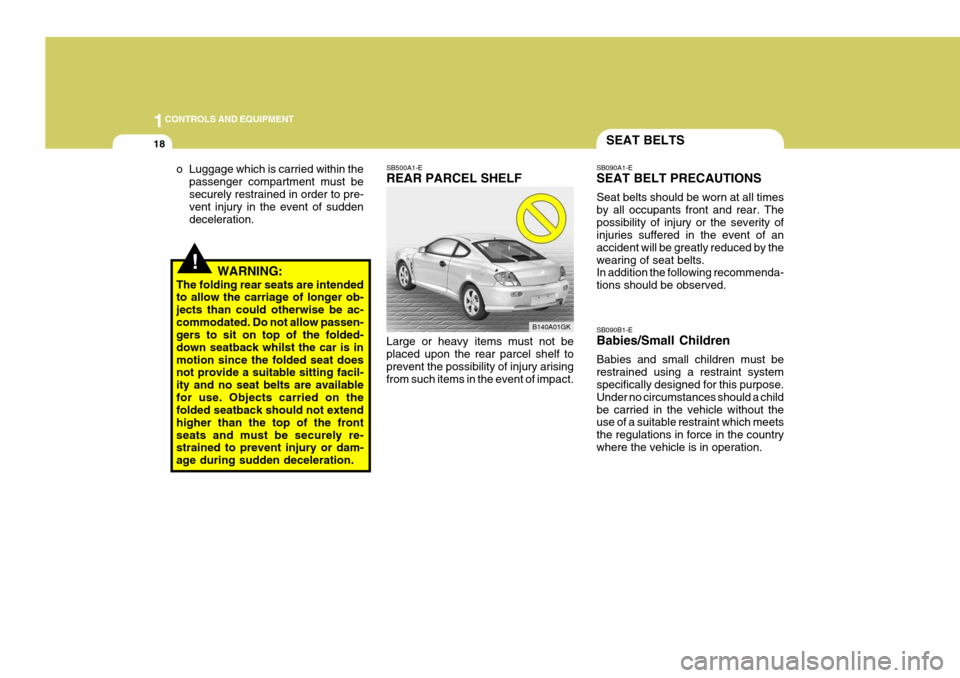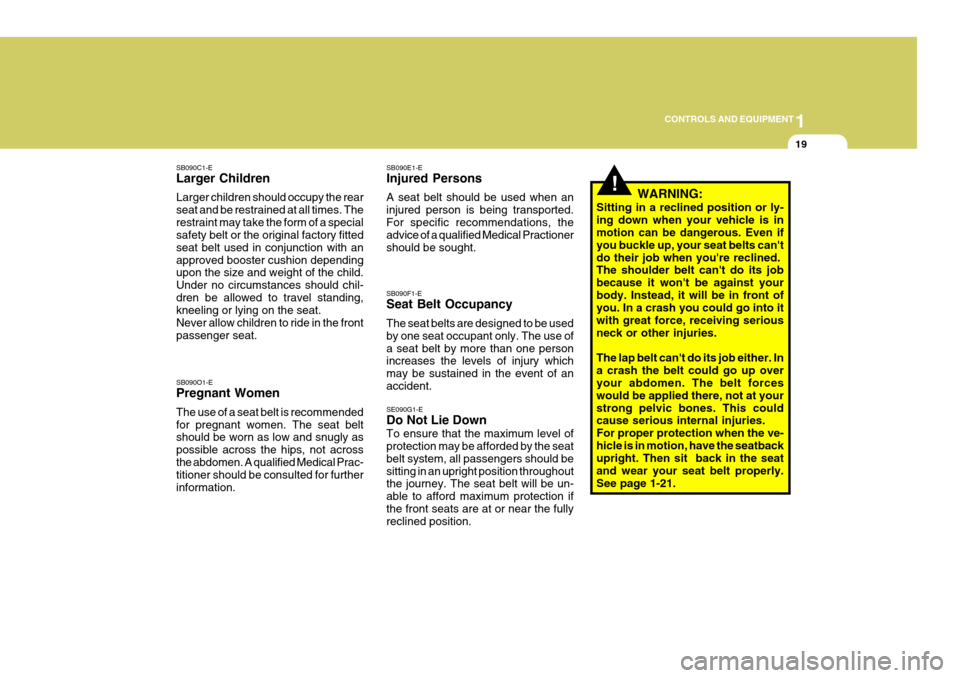2004 Hyundai Coupe child seat
[x] Cancel search: child seatPage 29 of 389

FEATURES OF YOUR HYUNDAI 1- 21
B240B01GK-GAT SRS Components and Functions The SRS consists of the following components: - Driver's Airbag Module - Passenger's Airbag Module- SRS Service Reminder Indicator (SRI)- SRS Control Module (SRSCM) The SRSCM continually monitors all elements while the ignition is "ON" to determine if a frontalor near-frontal impact is severe enough to re-quire airbag deployment. The SRS service reminder indicator (SRI) on the instrument panel will blink for about 6 secondsafter the ignition key is turned to the "ON" positionor after the engine is started, after which the SRIshould go out.
o Do not tamper with or disconnect SRS
wiring, or other components of the SRSsystem. Doing so could result in injury,due to accidental firing of the airbags orby rendering the SRS inoperative.
o Do not install a child restraint system in the front passenger seat position. A childrestraint system must never be placed inthe front seat. The infant or child could beseverely injured or killed by an airbagdeployment in case of an accident.
o Do not allow children to ride in the front passenger seat. If older children (teenag-ers and older) must ride in the front seat,make sure they are always properly beltedand that the seat is moved back as far aspossible.
o For maximum safety protection in all types of crashes, all occupants including thedriver should always wear their seat beltswhether or not an airbag is also providedat their seating position to minimize therisk of severe injury or death in the eventof a crash. Do not sit or lean unnecessarilyclose to the airbag while the vehicle is inmotion.
o The SRS airbag system must deploy very rapidly to provide protection in a crash. Ifan occupant is out of position because ofnot wearing a seat belt, the airbag mayforcefully contact the occupant causingserious or fatal injuries.
B240B01L
The airbag modules are located both in the center of the steering wheel and in the frontpassenger's panel above the glove box. Whenthe SRSCM detects a considerable impact to thefront of the vehicle, it will automatically deploy theairbags. CAUTION: Do not install or place any accessories (drinkholder, cassette holder, sticker, etc) on thefront passenger's panel above the glove boxin a vehicle with a passenger's air bag. Suchobjects may become dangerous projectilesand cause injury if the passenger's air baginflates.
B240B02L
Upon deployment, tear seams molded directly into the pad covers will separate under pressurefrom the expansion of the airbags. Further open-ing of the covers then allows full inflation of theairbags.
Page 32 of 389

FEATURES OF YOUR HYUNDAI
1- 24 o Do not tamper with or disconnect SRS
wiring, or other components of the SRS system. Doing so could result in injury,due to accidental firing of the airbags orby rendering the SRS inoperative.
o If components of the airbag system must be discarded, or if the vehicle must be
scrapped, certain safety preca utions must
be observed. Your Hyundai dealer knowsthese precautions and can give you the
necessary information. Failure to followthese precautions and procedures could
increase the risk of personal injury.
o If you sell your vehicle, be sure to inform the new owner of these important pointsand make certain that this manual is trans-ferred to the new owner.
o If your car was flooded and has soaked carpeting or water on flooring, youshouldn't try to start engine; have the car
towed to authorized Hyundai dealer.
WARNING:
o Do not install a child restraint system in
the front passenger seat position.
A child restraint system must never be placed in the front seat. The infant or childcould be severely injured by an airbagdeployment in case of an accident.
o Extreme Hazard! Do not use a reward facing restraint on a seat protected by anairbag in front of it!
o Modification to SRS components or wir- ing, including the addition of any kind ofbadges to the pad covers or modifications
to the body structure, can adversely affectSRS performance and lead to possibleinjury.
o For cleaning the airbag pad covers, use only a soft, dry cloth or one which hasbeen moistened with plain water. Solventsor cleaners could adversely affect theairbag covers and proper deployment ofthe system.
o No objects should be placed over or near the airbag modules on the steering wheel,instrument panel, and the frontpassenger's panel above the glove box,because any such object could cause harmif the vehicle is in a crash severe enoughto cause the airbags to inflate.
o If the airbags inflate, they must be re- placed by an authorized Hyundai dealer.
Page 166 of 389

INDEX10-1
Catalytic Converter
.................................................................... 7-1 ~ 7-2
CD Auto changer (H250, H260) .............................................. 1-70, 1-77
Child Restraint system ........................................................... 1-14 ~ 1-19
Child Seat Restraint Suitability For Seat Position ............................1-18
Cigarette Lighter ................................................................................ 1-37
Clock ................................................................................................ 1-36
Clutch Checking fluid ............................................................................... 6-13
Pedal free play ............................................................................. 6-16
Combination Light Daytime running lights .................................................................. 1-34
Headlight flasher ........................................................................... 1-34
Headlight switch ........................................................................... 1-33
High-beam switch ......................................................................... 1-34
Lane change signal ...................................................................... 1-33
Turn signal operation .................................................................... 1-33
Compact Disk Player Operation (H260) ........................................... 1-75
Cooling Fans ..................................................................................... 6-19
Corrosion Protection Cleaning the interior ....................................................................... 4-3
Protecting your Hyundai from corrosion ................ ......................... 4-1
Washing and waxing ...................................................................... 4-2
Cruise Control ................................................................................... 1-47
D Defrosting/Defogging ......................................................................... 1-54
Door
Central door lock ............................................................................ 1-5
Door locks ...................................................................................... 1-3 Locking and unlocking front door with a key ................................. 1-4
Drink Holder ...................................................................................... 1-38
Drive Belts ........................................................................................ 6-17
ZK000A1-G 10. INDEX A
Air bag ....................................................................................
1-20 ~ 1-24
Air cleaner filter ................................................................................. 6-10
Air Conditioning Care .............................................................................................. 6-14
Operation ...................................................................................... 6-14
Switch ........................................................................................... 1-55
Air filter .............................................................................................. 1-62
Antenna ............................................................................................. 1-87
Ashtray .............................................................................................. 1-37
Audio Fault Code .............................................................................. 1-79
Automatic Transaxle ........................................................................... 2-6 B Battery ...................................................................................... 2-11, 6-18
Brake Anti-lock system ............................................................................. 2-9
Checking the brakes .................................................................... 6-13
Fluid .............................................................................................. 6-13
Pedal clearance ............................................................................ 6-16
Pedal free play ............................................................................. 6-16
Practices ......................................................................................... 2-8
Breaking-In your new Hyundai ........................................................... 1-1
C Care of Cassette tapes .......................................................... 1-85 ~ 1-86
Care of Disk ...................................................................................... 1-85
Cassette Tape Player Operation (H250) ..........................................1-68
10
Page 181 of 389

1
Fuel Recommendations ............................................... 1-2
Running In Your New Hyundai ..................................... 1-3
Immobiliser System ...................................................... 1-4
Door Locks ................................................................... 1-6
Theft-Alarm System ...................................................... 1-8
Power Windows ..........................................................1-11
Seats .......................................................................... 1-12
Seat Belts ................................................................... 1-18
Child Restraint System............................................... 1-22
Supplemental Restraint (AIRBAG) System ............... 1-30
Instrument Cluster and Indicator Lights ..................... 1-38
Warning and Indicator Lights ..................................... 1-40
Trip Computer ............................................................ 1-47
Multi Gauge ................................................................ 1-49
Multi-function Switch .................................................. 1-50
Windscreen Wiper/Washer Switch ............................. 1-52
Sunroof ....................................................................... 1-59
Mirror .......................................................................... 1-62
Bonnet Release .......................................................... 1-65
Cruise Control ............................................................ 1-70
Audio Remote Control ................................................ 1-73
Heating and Cooling Control ...................................... 1-75
Stereo Sound System ................................................ 1-93
Antenna ...................................................................... 1-97
CONTROLS AND EQUIPMENT
1
Page 186 of 389

1CONTROLS AND EQUIPMENT
6
!
DOOR LOCKS
B040A02Y-EAT
WARNING:
o Unlocked doors can be danger- ous. Before you drive away (es- pecially if there are children inthe car), be sure that all the doors are securely closed and locked so that the doors cannot be inad-vertently opened from the inside. This helps ensure that doors will not be opened accidentally. Also,when combined with the proper use of seat belts, locking the doors helps keep occupants frombeing ejected from the car in case of an accident.
o Before opening the door, always look for and avoid oncoming traf-fic.
o In case of accident the door is unlocked automatically (Not allmodels). B040B01A-AAT Locking and unlocking front doors with a key
o The door can be locked or unlocked
with a key.
o Lock the door by turning the key toward the front of the vehicle and unlock it by turning the key towardthe rear. HGK2008-E
UNLOCK
LOCK B040C01S-AAT Locking From the Outside The doors can be locked without a key. To lock the doors, first push the inside lock switch to the "LOCK" position sothat the red mark on the switch is not visible, then close the door. NOTE:
o When locking the door this way,
be careful not to lock the door with the ignition key left in thevehicle.
o To protect against theft, always
remove the ignition key, close allwindows, and lock all doors when leaving your vehicle unattended. HGK2009-E
Page 192 of 389

1CONTROLS AND EQUIPMENT
12
!
!WARNING:
To ensure the seat is locked se- curely, attempt to move the seatforward or rearward without using the lock release lever.
SEATS
!
WARNING:
1) Be careful that someone's head, hands and body are not trapped by a closing window.
2) Never try to operate the main switch on the driver's door andthe individual door windowswitch in opposing directions at the same time. If this is done, the window will stop and cannot beopened or closed.
3) Do not leave children alone in the
car. Always remove the ignitionkey for their safety. SB070A1-E FRONT SEAT ADJUSTMENT
WARNING:
Front seat adjustments must not be undertaken whilst the vehicle is in motion. Loss of control of the ve-hicle may result if seat adjustments are made whilst the vehicle is in motion. SB070B2-E Front seat rake adjustment The front seat rake adjustment is per- formed by raising the lever at the front of the seat base and sliding the seat to the desired position. At this positionthe lever should be released and the seat rocked to and fro to ensure that the mechanism has locked.
HGK2027-E
Page 198 of 389

1CONTROLS AND EQUIPMENT
18
SB090B1-E Babies/Small Children Babies and small children must be restrained using a restraint system specifically designed for this purpose. Under no circumstances should a childbe carried in the vehicle without the use of a suitable restraint which meets the regulations in force in the countrywhere the vehicle is in operation.
SEAT BELTS
!WARNING:
The folding rear seats are intended to allow the carriage of longer ob- jects than could otherwise be ac-commodated. Do not allow passen- gers to sit on top of the folded- down seatback whilst the car is inmotion since the folded seat does not provide a suitable sitting facil- ity and no seat belts are availablefor use. Objects carried on the folded seatback should not extend higher than the top of the frontseats and must be securely re- strained to prevent injury or dam- age during sudden deceleration. SB500A1-E REAR PARCEL SHELF Large or heavy items must not be placed upon the rear parcel shelf to prevent the possibility of injury arisingfrom such items in the event of impact.
SB090A1-E SEAT BELT PRECAUTIONS Seat belts should be worn at all times by all occupants front and rear. Thepossibility of injury or the severity of injuries suffered in the event of an accident will be greatly reduced by thewearing of seat belts. In addition the following recommenda- tions should be observed.
B140A01GK
o Luggage which is carried within the
passenger compartment must besecurely restrained in order to pre- vent injury in the event of sudden deceleration.
Page 199 of 389

1
CONTROLS AND EQUIPMENT
19
WARNING:
Sitting in a reclined position or ly- ing down when your vehicle is in motion can be dangerous. Even if you buckle up, your seat belts can'tdo their job when you're reclined. The shoulder belt can't do its job because it won't be against yourbody. Instead, it will be in front of you. In a crash you could go into it with great force, receiving seriousneck or other injuries. The lap belt can't do its job either. In a crash the belt could go up over your abdomen. The belt forces would be applied there, not at yourstrong pelvic bones. This could cause serious internal injuries. For proper protection when the ve-hicle is in motion, have the seatback upright. Then sit back in the seat and wear your seat belt properly.See page 1-21.
SB090C1-E Larger Children Larger children should occupy the rear seat and be restrained at all times. Therestraint may take the form of a special safety belt or the original factory fitted seat belt used in conjunction with anapproved booster cushion depending upon the size and weight of the child. Under no circumstances should chil-dren be allowed to travel standing, kneeling or lying on the seat. Never allow children to ride in the frontpassenger seat. SB090O1-E Pregnant Women The use of a seat belt is recommended for pregnant women. The seat belt should be worn as low and snugly as possible across the hips, not acrossthe abdomen. A qualified Medical Prac- titioner should be consulted for further information. SB090E1-E Injured Persons A seat belt should be used when an injured person is being transported.For specific recommendations, the advice of a qualified Medical Practioner should be sought. SB090F1-E Seat Belt Occupancy The seat belts are designed to be used by one seat occupant only. The use of a seat belt by more than one person increases the levels of injury which may be sustained in the event of anaccident.!
SE090G1-E Do Not Lie Down To ensure that the maximum level of protection may be afforded by the seat belt system, all passengers should besitting in an upright position throughout the journey. The seat belt will be un- able to afford maximum protection ifthe front seats are at or near the fully reclined position.